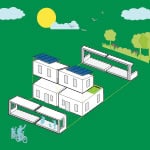
Katrin Klingenberg
At the beginning of 2012, there were only about a dozen certified Passive House projects in the US. That was two years ago, and now we’re about to pass the 100 mark for PHIUS certifications. With standards that cut building energy consumption by 60 to 80 percent and an expanding core of passive design and construction professionals, we only expect that amount of growth to continue.
But there are associated growing pains that can hinder understanding and adoption—starting with the misconceptions about the term “passive house.”
The (Unfortunate) Name
The name Passive House is unfortunate. It was retranslated into English from the German term passivhaus (more on that in a minute), it often leads people to believe that you can only build passive houses—as in single-family residences. In fact, passive house is a generic term referring to a set of design and construction principles, as well as a quantifiable energy performance standard that has evolved to be applicable to any type of building. Yes, PHIUS is known for certifying residential projects, but it has also certified commercial projects, and other applications are growing quickly. As a result, here in the United States and Canada, it actually makes more sense to use the term “passive building.”
Because of the sometimes-used German spelling passivhaus, there’s a common misunderstanding that passive house principles—superinsulation, airtightness, high-performance windows, energy recovery ventilation, and solar gain management—originated in Europe. Those principles were actually pioneered in the United States and Canada, and the term was coined by an American physicist named William Shurcliff in the early 1980s. The Germans adopted the term from the North American pioneers and translated it directly into passivhaus.
Although advancing the principles fell dormant in North America for a variety of reasons, the Europeans did terrific work refining them and spawning a burst of high-performance buildings and manufacturing of Passive House building components in Europe.
THE LEED Comparison
Another common misconception: that Passive House is like LEED and therefore is a direct competitor. Passive house differs from LEED in its intense focus on energy performance; it uses sophisticated modeling software to verify predicted performance at the design stage. As most know, LEED is checklist-based, and as such, it is what is known as a prescriptive rather than a performance standard. But, LEED and PHIUS certification are not necessarily mutually exclusive. Accomplishing PHIUS requires, tacitly, meeting a majority of the LEED prescriptive checklist requirements. And, with just a little extra effort, several PHIUS-certified projects have also earned LEED status.
The Magic Number
And that leads to the next frontier in terms of making passive building mainstream: The standard itself. The Europeans arrived at a magic number in terms of consumption for heating and cooling energy: 15 kWh/m2/yr. That figure is indeed realistic for the Central European climate zone and in similar North American climate zones such as the Pacific Northwest.
A precept of the European passivhaus concept is that the figure is universal, achievable, and cost-effective virtually everywhere. As compelling and alluring as that Holy Grail is, having reviewed and consulted on projects across North America’s much more varied and extreme climates, we’ve learned one size does not fit all.
In some cases, the cost of hitting that number is prohibitive and provides a disincentive to passive building. And in others—parts of California, for example—the standard actually is too easy to attain, and projects can hit the mark while leaving cost-effective energy savings on the table.
Finally, that fixed number is actually harder to attain in small buildings—which runs counter to reducing energy consumption and carbon levels. Acknowledging that the standard is not universal is considered heresy by some, but it is absolutely necessary if we are to achieve the potential energy savings that the passive approach can yield in new and retrofit scenarios. Consequently, the PHIUS Technical Committee—a volunteer body of experienced passive-building and building-science experts—is undertaking the task of adjusting the standard according to all the DOE climate zones.
For more on Passive House check out our feature story, “Welcome to the Passive House Party,” and Q&As with Passive House proponents Lukas Armstrong and Vahid Mojarrab.

